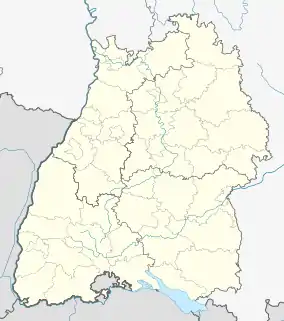Little House, Meersburg
The Little House, also called the Prince's House (Fürstenhäusle), is a historic house and museum located in Meersburg, Germany, overlooking Lake Constance. It was the residence of the poet Annette von Droste-Hülshoff, to whom the museum is dedicated.
| Little House | |||||||||||||||
|---|---|---|---|---|---|---|---|---|---|---|---|---|---|---|---|
Fürstenhäusle | |||||||||||||||
_Ostseite.jpg.webp) The Little House seen from the southeast, at the end of a paved path.
| |||||||||||||||
| |||||||||||||||
| Website | |||||||||||||||
| www | |||||||||||||||
History
The Little House was built some time around 1600 by Jakob Fugger,[1] a canon of the diocese of Constance and descendant of Jakob Fugger the Rich. In 1604, he became the Prince-Bishop of Constance,[2] though he continued to reside at the Little House until his death in 1626.[1][2] So did succeeding Prince-Bishops,[1] giving the residence its name (Fürstenhäusle),[3] until the Prince-Bishopric was secularized in 1803 and absorbed into the Electorate of Baden.[4] After secularization, the Little House stood empty.[5]
Over two centuries after Prince-Bishop Fugger's death, in 1797, the poet Annette von Droste-Hülshoff was born. She began to find literary success at a young age, but was weighed down with familial obligations, and frequently ill. To find solace, the poet frequently spent time in Meersburg with her sister and her husband,[6] Joseph von Laßberg, at Meersburg Castle.[5] From 1841 especially, Droste-Hülshoff spent most of her time in Meersburg, where,[6] in November 1843, the Little House went to auction. Droste-Hülshoff, desiring a private residence for herself in later years, participated with little competition. Thus, the purchase came out to 400 Reichsthaler,[5] a sum supplied by her own revenue and Laßberg's annuity.[6] The poet was very fond of her purchase and wrote glowingly of it in letters to friends and family.[1][4][5] However, she had never resided there by the time she died in 1848, aged 51.[4]
Droste-Hülshoff's descendants transformed the Little House into a museum dedicated to their forebear and her works in 1923.[1] Carl von Droste-Hülshoff also added a new wing and moved the entrance.[3]
In 1947, Heinrich von Bothmer-Schwegerhoff, another descendant of Droste-Hülshoff, and his American wife, Helen von Bothmer, moved into the Little House. Bothmer operated the museum until her death in 1996 and endowed a literary prize for women poets, the Droste Prize, in 1957.[7]
Staatliche Schlösser und Gärten Baden-Württemberg (SSG), the public entity that manages State properties in Baden-Württemberg, closed the Little House in late 2016 for renovations funded proceeds from the Glücksspirale lottery. The Little House was to be reopened in September with a new exhibit dedicated to Annette von Droste-Hülshoff, a collaboration between SSG and the Droste Research Center of the Landschaftsverband Westfalen-Lippe.[8]
Grounds and architecture

When Annette von Droste-Hülshoff was residing at the Little House, it consisted of a state room and a kitchen on the ground floor, which housed a staircase into a common room and bedrooms for herself and a maid. Droste-Hülshoff described the state room as a "glass case" having an oriel with a canapé, heated with a tile stove. Memorabilia from the poet's time, such as photographs and coins, are also found here. In the alcove nearby is located Droste-Hülshoff's collection of jewels.[9] The upstairs room the poet described as a "swallow's nest",[3] decorated now with copies of Droste-Hülshoff's manuscripts, miniature portraits, and family photographs. Also on display here are valuable textiles and books,[9] such as first-edition copies of works by herself, Goethe, and Levin Schücking.[10] During her ownership of the Little House, Droste-Hülshoff had it repainted.[11]
The portion of the Little House that existed when Annette von Droste-Hülshoff purchased the house is arranged as she described it. Within that portion is a museum dedicated to Droste-Hülshoff's life work.[9] It contains artifacts such as silhouettes Droste-Hülshoff made, locks of her hair, and letters and writing instruments of hers.[12]
The wing added by Carl von Droste-Hülshoff is now the visitor's center.[3]
See also
| Wikimedia Commons has media related to Little House, Meersburg. |
Citations
- Little House: Prince's Little House.
- Little House: Jakob Fugger.
- Little House: Structure.
- Little House: Milestones.
- Little House: Anecdotes.
- Little House: Annette von Droste-Hülshoff.
- Little House: Helen von Bothmer.
- "Fürstenhäusle eröffnet im September mit neuer Ausstellung". Südkurier (in German). 24 May 2018. Retrieved 6 July 2020.
- Little House: Exhibition.
- Little House: Poet's works.
- Little House: Rooms.
- Little House: Personal items and nostalgia.
References
- "Meersburg Prince's Little House". Staatliche Schlösser und Gärten Baden-Württemberg. Retrieved 10 February 2020.
- "The Structure". Staatliche Schlösser und Gärten Baden-Württemberg. Retrieved 10 February 2020.
- "The Rooms". Staatliche Schlösser und Gärten Baden-Württemberg. Retrieved 10 February 2020.
- "Personal Items and Nostalgia". Staatliche Schlösser und Gärten Baden-Württemberg. Retrieved 10 February 2020.
- "The Poet's Works". Staatliche Schlösser und Gärten Baden-Württemberg. Retrieved 10 February 2020.
- "Rooms full of memories". Staatliche Schlösser und Gärten Baden-Württemberg. Retrieved 10 February 2020.
- "Milestones". Staatliche Schlösser und Gärten Baden-Württemberg. Retrieved 11 February 2020.
- "Jakob Fugger". Staatliche Schlösser und Gärten Baden-Württemberg. Retrieved 11 February 2020.
- "Annette von Droste-Hülshoff". Staatliche Schlösser und Gärten Baden-Württemberg. Retrieved 11 February 2020.
- "Helen von Bothmer". Staatliche Schlösser und Gärten Baden-Württemberg. Retrieved 11 February 2020.
- "Anecdotes". Staatliche Schlösser und Gärten Baden-Württemberg. Retrieved 11 February 2020.
External links
- Official website (in English)
- "Fürstenhäusle" on Meersburg's official website (in English)


